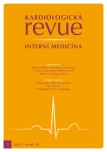The profile of patients with acute heart failure managed in pre‑hospital setting
Authors:
J. Svoboda 1; M. Felšöci 2,3; S. Littnerová 4; J. Pařenica 2,3; M. Pavlušová 2; J. Jarkovský 4; J. Špinar 2,3
Authors‘ workplace:
Zdravotnická záchranná služba Jihomoravského kraje, p. o., Brno
1; Interní kardiologická klinika LF MU a FN Brno
2; Mezinárodní centrum klinického výzkumu, FN u sv. Anny v Brně
3; Institut biostatistiky a analýz, LF a PřF MU, Brno
4
Published in:
Kardiol Rev Int Med 2014, 16(5): 386-390
Category:
Cardiology Review
Overview
Purpose:
To describe the profile and management of patients with acute heart failure (AHF) in pre‑hospital care in the Czech Republic.
Methods:
Registry data of the Emergency Medical System (EMS) of the South Moravian region of Czech Republic were used. Patients with suspected AHF were enrolled consecutively during the period of January 2010– December 2011. Excluded were patients who died or had cardiac arrest before the arrival of EMS and those who presented with dyspnea of dominantly extra- cardiac etiology. We compared patients who were transported to the hospital with those treated in an outpatient setting. Overall mortality within the first 30 days after the initial EMS contact was assessed as a main endpoint.
Results:
From the 131,798 of patients who called EMS, 1,964 (1.5%) of cases were suspected of having AHF. The diagnosis of AHF was determined in 1,310 patients who were transported to the hospital; 35 were treated in Outpatients. The mean age of the study population was 78 years, the most common comorbidity was hypertension (67.0%) and almost one half of the study population had signs of pulmonary edema before being admitted to hospital (46.4%). Patients not transported to hospital were more frequently of male gender (71.4% vs. 49.1%), with lower incidence of comorbid conditions and did not have signs of respiratory distress (oxygen saturation 96% vs. 87% in those transported to the hospital; no signs of pulmonary edema). The most common drug used in pre‑hospital care in patients with suspected AHF was furosemide (74.0% patients). The 30- day mortality rate of the whole study population reached 20.7%.
Conclusion:
AHF represents 1.5% of all emergency calls due to acute symptoms. The vast majority of the patients are transported to the hospital with the assumption of hospitalization. Early mortality rates of these patients are high.
Keywords:
acute – heart failure – survival – emergency medical system
Sources
1. Dickstein K, Cohen‑ Solal A, Filippatos G et al. ESC Guidelines for the diagnosis and treatment of acute and chronic heart failure 2008: the Task Force for the Diagnosis and Treatment of Acute and Chronic Heart Failure 2008 of the European Society of Cardiology. Developed in collaboration with the Heart Failure Association of the ESC (HFA) and endorsed by the European Society of Intensive Care Medicine (ESICM). Eur Heart J 2008; 29: 2388– 2442. doi: 10.1093/ eurheartj/ ehn309.
2. De Luca L, Fonnarow GC, Adams KF Jr et al. Acute heart failure syndromes: clinical scenarios and pathophysiologic targets for therapy. Heart Fail Rev 2007; 12: 97– 104.
3. Adams KF Jr, Fonarow GC, Emerman CL et al. Characteristics and outcomes of patients hospitalized for heart failure in the United States: Rationale, design, and preliminary observations from the first 100,000 cases in the Acute Decompensated Heart Failure National Registry (ADHERE). Am Heart J 2005; 149: 209– 216.
4. Spinar J, Parenica J, Vitovec J et al. Baseline characteristics and hospital mortality in the Acute Heart Failure Database (AHEAD) Main registry. Crit Care 2011; 15: R291. doi: 10.1186/ cc10584.
5. Zannad F, Mebazaa A, Juilliére Y et al. Clinical profile, contemporary management and one‑year mortality in patients with severe acute heart failure syndromes: The EFICA study. Eur J Heart Fail 2006; 8: 697– 705.
6. Nieminen MS, Brutsaert D, Dickstein K et al. EuroHeart Failure Survey II (EHFS II): a survey on hospitalized acute heart failure patients: description of population. Eur Heart J 2006; 27: 2725– 2736.
7. Špinar J, Janský P, Kettner et al. Doporučení pro diagnostiku a léčbu akutního srdečního selhání. Cor Vasa 2006; 48: K3– 31.
8. Bonatti J, Göschl O, Larcher P et al. Predictors of short‑term survival after helicoper rescue. Resuscitation 1995; 30: 133– 140.
9. Zeman K, Pohludková L, Špinar J et al. Krátkodobá prognóza a léčba pacientů hospitalizovaných pro akutní srdeční selhání v regionální nemocnici bez kardiocentra. Vnitr Lek 2012; 58: 273– 279.
10. Parenica J, Spinar J, Vitovec J et al. Long‑term survival following acute heart failure: The acute heart failure database Main registry (AHEAD Main). Eur J Intern Med 2013; 24: 151– 160. doi: 10.1016/ j.ejim.2012.11.005.
11. Teboul A, Gaffinel A, Meune C et al. Management of caute dyspnea: use and feasibility of brain natriuretic peptide (BNP) assay in the prehospital setting. Resuscitation 2004; 61: 91– 96.
12. Prosen G, Klemen P, Strnad M et al. Combination of lung ultrasound (a comet‑ tail sign) and N‑terminal pro‑brain natriuretic peptide in differentiating acute heart failure from chronic obstructive pulmonary disease and asthma as cause of acute dyspnea in prehospital emergency setting. Crit Care 2011; 15: R114. doi: 10.1186/ cc10140.
13. Wuerz RC, Meador SA. Effects of prehospital medications on mortality and length of stay in congestive heart failure. Ann Emerg Med 1992; 21: 669– 674.
14. Hoffman JR, Reynolds S. Comparison of nitroglycerin, morphine and furosemide in treatment of presumed pre‑hospital pulmonary edema. Chest 1988; 92: 586– 593.
15. Hubble MW, Richards ME, Jarivs R et al. Effectiveness of prehospital continuous positive airway pressure in the management of acute pulmonary edema. Prehosp Emerg Care 2006; 10: 430– 439.
Labels
Paediatric cardiology Internal medicine Cardiac surgery CardiologyArticle was published in
Cardiology Review

2014 Issue 5
Most read in this issue
- Treatment of anemia and iron deficiency from the hematologist’s perspective
- Antiphospholipid syndrome – diagnostics, manifestation and treatment
- Adverse effects of biological therapy in rheumatology
- Systemic sclerosis
